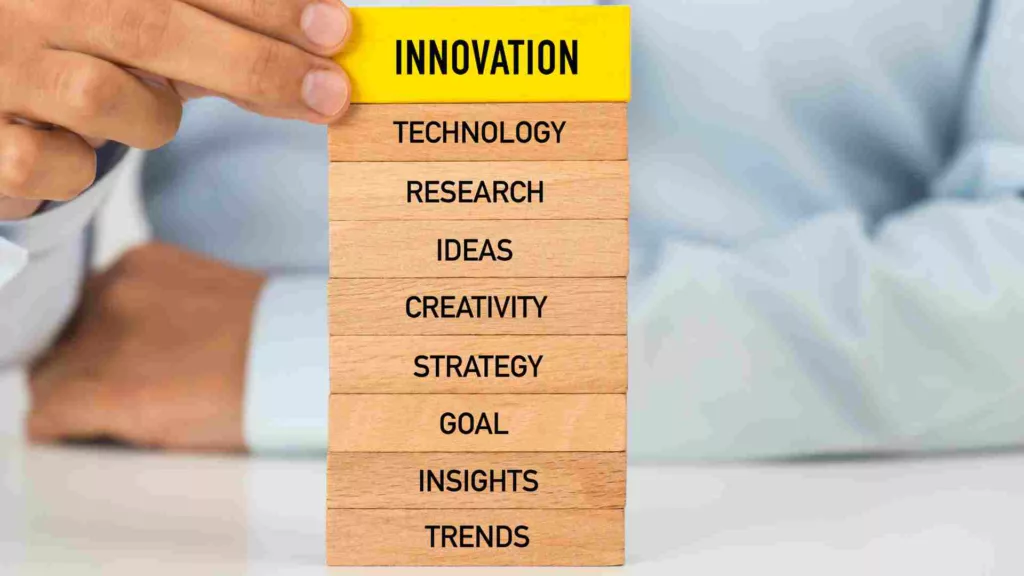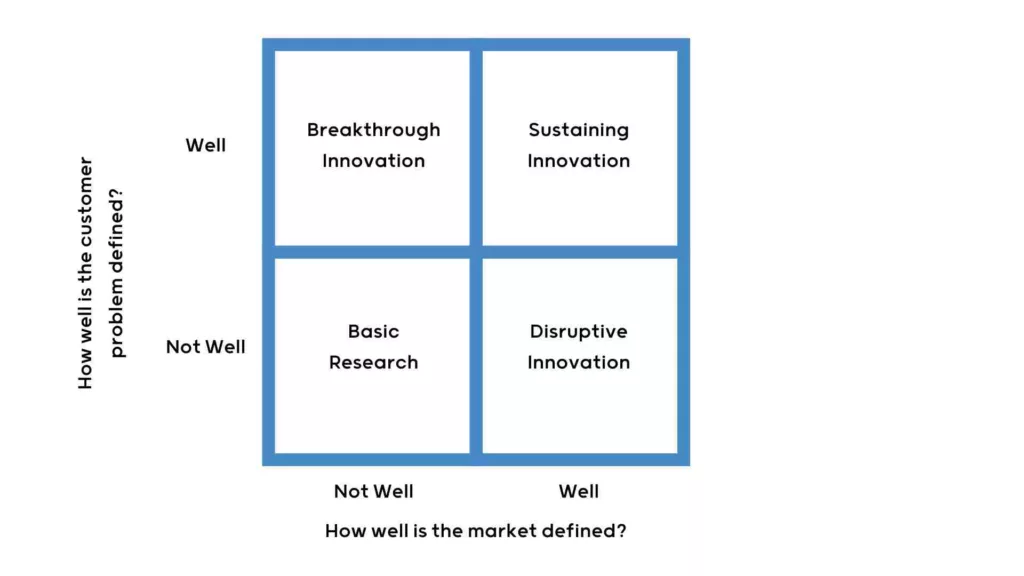Posted in Blog, Innovation, Innovation by Jo North
The Levels of Innovation: A Deep Dive
Different levels of innovation are always visible in the fast-changing business world. In recent years, the importance of business innovation has grown exponentially as the global landscape becomes more competitive. Businesses are also innovating to become more sustainable.
Different types and levels of innovation can be witnessed across various industries, leading to new products, new markets, and even new business models. But how can you categorize these innovations, and use them strategically in your own business?
This article delves into seven of the main types, or levels of innovation, and the role they can play in shaping your company’s future.

Levels of Innovation
1. Incremental Innovation
Incremental innovation involves small improvements or minor changes to an existing product or process. It focuses on continuous improvement, ensuring that businesses maintain or increase their market share.
An example of incremental innovation is adding new features to mobile phones, enhancing the user interface for better customer satisfaction or streamlining production. While it may not be a major change, it keeps products fresh and relevant, or processes efficient and profitable.
2. Sustaining Innovation
Sustaining innovation improves existing products or services, making them more efficient or effective. It usually aims to defend or retain, rather than build market share in the face of competitor activity.

3. Game-Changing Innovation
Game-changing innovation, as the term suggests, refers to a transformational breakthrough that fundamentally reshapes a market, industry, or sector. These innovations redefine rules, standards, and practices, giving their adopters a significant competitive advantage. Game-changing innovations often disrupt the status quo, making previous methods or technologies obsolete and setting a new direction for the future. They’re not just improvements; they’re paradigm shifts.
Characteristics of Game-Changing Innovation:
- Redefines Competition: It often resets the competitive landscape, rendering older methods or products obsolete and making it challenging for traditional players to compete unless they adapt.
- Creates or Transforms Markets: This type of innovation might create entirely new markets or drastically change the landscape of existing ones.
- Involves Novelty: It’s not just about making something better but about introducing something fundamentally different.
- Sets New Standards: Other businesses often need to adopt similar changes to stay relevant, making the innovation a new benchmark or standard in the industry.
- Has Broad Impact: Game-changing innovations usually have ripple effects, influencing related industries and societal behaviors.
Example of Game-Changing Innovation
Electric Cars (e.g., Tesla) are an example of game-changing innovation. Manufacturers not only introduced a new propulsion system but also revolutionized car design, software integration, and energy consumption patterns in transportation.
Why Is Game-Changing Innovation Important?
For businesses, recognizing or creating game-changing innovations can lead to unprecedented growth and market dominance. However, they also come with risks, as they might require significant investment, and success isn’t guaranteed. Still, companies that achieve game-changing innovation and can scale it effectively often become industry leaders.
For an innovation to be genuinely game-changing, it must provide a compelling value proposition to users, be scalable, and be difficult for competitors to replicate quickly. Businesses aiming for this level of innovation must be prepared for long-term investments, iterative testing, and the need to pivot based on feedback and changing circumstances.

Types of Game-Changing Innovation
Breakthrough, radical, and disruptive innovations are types of game-changing innovation. These terms are often used interchangeably, but they do have distinct nuances. Understanding these differences can help you to better strategize your innovation efforts. Let’s look at each type:
Breakthrough Innovation
Definition: Breakthrough innovations refer to significant advancements or discoveries that lead to the development of entirely new concepts, products, or processes. These innovations usually result from extensive research and development and open up new possibilities previously considered unattainable.
Example: The discovery of penicillin. Before its discovery, bacterial infections were often fatal, but penicillin introduced a new era of antibiotics and revolutionized medical treatment.
Radical Innovation
Definition: Radical innovations are those that represent a significant departure from existing practices or products. They introduce entirely new paradigms and can render existing products or processes obsolete. Radical innovation is often about major shifts and radical changes in technology, or the development of entirely new technologies.
These innovations can redefine industries and open doors to new markets.
Examples: The transition from typewriters to personal computers. This shift introduced a completely new way of processing and storing information, revolutionizing the world of work and personal productivity.
We are currently experiencing an AI-driven innovation step change.
Disruptive Innovation
Definition: Coined by Clayton Christensen of Harvard Business School, disruptive innovation describes innovations that initially cater to overlooked segments of a market (often the lower end) and then eventually upend an existing market by displacing established industry leaders, products, and alliances. Disruptive innovations might not be “better” by existing standards when they first emerge; they’re typically simpler, more affordable, or more convenient and then improve over time. They disrupt existing markets and value networks.
Examples: The rise of Netflix. Initially, it provided a simple mail-order DVD service, an alternative to video rental stores. As the platform evolved and introduced streaming, it disrupted and transformed the entire film and TV industry, pushing out traditional rental services.
Another example of disruptive innovation is how cryptocurrency has disrupted financial markets.
Summary of Distinguishing Features between Breakthrough, Radical and Disruptive Innovation
- Source: Breakthrough innovations often arise from foundational research and represent entirely new concepts. Radical innovations stem from significant departures in technology or methodology. Disruptive innovations may not necessarily be technologically novel but redefine market dynamics.
- Market Impact: Breakthrough innovations create new markets or opportunities. Radical innovations can redefine or render existing markets obsolete. Disruptive innovations start by serving a niche market segment before eventually overtaking mainstream market segments.
- Technological Sophistication: While breakthrough and radical innovations usually involve sophisticated, cutting-edge technology, disruptive innovations may initially rely on simpler or pre-existing technologies before evolving.
Understanding these distinctions is crucial for recognizing opportunities, forecasting industry shifts, and positioning your business accordingly. Each type of innovation presents unique challenges and opportunities, and each can be essential in a comprehensive innovation strategy.
4. Architectural Innovation
Architectural innovation reconfigures existing product architectures (i.e. the way a product’s functional elements are designed) to serve new markets. For instance, technological innovation can lead to a product being restructured without changing its core components. Business leaders may take innovative ideas from one context and introduce them into another, achieving competitive advantage in an existing or new market segment.
An example is the Apple Watch. It uses technology from Apple phones, and applies them in this wearable format to create a new product for an existing market.

5. Business Model Innovation
Alex Osterwalder, known for his work on business models, has emphasized the importance of business-model innovation. This involves creating and implementing new ways of generating revenue and value proposition. For example, subscription services that changed the way we consume media content.
With climate change and the drive to decarbonisation, it is essential that businesses move towards sustainable business model innovation.
6. Process Innovation
Going beyond just new products, process innovation involves new ways of doing things within an organizational structure. It can lead to better overall performance, efficiency, and can have a significant impact on a company’s bottom line.
7. Transformational Innovation
Transformation innovation requires substantial innovation investments and is often driven by visionary business leaders. They can redefine an industry and set the standard for years to come.
Balancing Levels of Innovation
For business leaders, achieving the right balance between different innovation projects is crucial. Short term innovations, like incremental changes, offer quick wins, while long-term, transformational innovations might be the home runs that redefine industries. Both are essential for business plans.
Leveraging Levels of Innovation with The Innovation Matrix
The innovation matrix, a concept discussed in the Wall Street Journal and by other industry leaders, is a tool to help companies strategize their innovation efforts. It categorizes innovations based on their impact on the current market and the company’s core business. From new ideas that can lead to breakthrough innovations, to technological advancements that redefine industries, this matrix helps businesses find the right balance.
An innovation matrix is a strategic tool that can help businesses identify and prioritize opportunities for innovation. It provides a framework for analyzing and evaluating potential opportunities, which can help them focus on the most promising approach for growth.

The innovation matrix is typically a two-by-two grid with four quadrants or sections. The quadrants often represent various types of innovations, such as:
- Breakthrough innovation: This type of innovation creates a new market or fundamentally changes an existing market.
- Disruptive innovation: This type of innovation challenges the status quo and creates new opportunities for businesses that are able to adapt.
- Sustaining innovation: This type of innovation improves existing products or services, making them more efficient or effective.
- Basic research: This type of innovation is focused on developing new knowledge and technologies that may have potential applications in the future.
The axes of the innovation matrix can represent different factors, such as the cost of innovation, the risk of innovation, the time to market for innovation, or the potential impact of innovation. The specific factors that are used will depend on the specific needs of the business.
How to Use an Innovation Matrix in Your Business
To use an innovation matrix, you first need to identify potential opportunities for innovation. This can be done by brainstorming, conducting market research, or analyzing customer feedback. Once you’ve identified potential opportunities, place them in the appropriate quadrant of the innovation matrix.
The next step is to evaluate the potential opportunities in each quadrant. This involves considering factors such as the cost of innovation, the risk of innovation, the time to market for innovation, and the potential impact of innovation. You can then prioritize the opportunities based on your evaluation.
Here are some additional tips for using an innovation matrix:
- Make sure that the factors used on the axes of the matrix are relevant to the specific needs of the business.
- Be realistic about the cost of innovation, the risk of innovation, and the time to market for innovation.
- Don’t be afraid to experiment with different types of innovation.
- Get input from a variety of stakeholders, including employees, customers, and partners.
- Use the innovation matrix as a living document that can be updated as new opportunities and challenges emerge.
By following these tips, you can use the innovation matrix to develop a strategic approach to innovation that will help you to achieve your future growth goals.
Levels of Innovation: Challenges
The innovation process is not without challenges. Large companies may struggle with the agility required for breakthrough innovation. Different people within a team might view innovation in different ways. Best practice recommends an inclusive approach, involving team members from different areas of the business in the innovation program.
Innovation is more than just a buzzword; it’s the process of harnessing new technology, innovative solutions, and innovative ideas to achieve competitive advantage in a competitive market. Whether focusing on basic research, product development, or business model innovation, the biggest advantage is gained by those who understand the various levels of innovation and can execute on them effectively.
Innovation is essential for organizations of all sizes. Whether you’re looking to add new features to an existing product, break into new markets with a breakthrough product, or redefine an industry with transformational innovation, understanding the different levels and types of innovation is the first step. Innovative companies, whether aiming for small wins or industry-defining home runs, recognize the need to constantly evolve and challenge the status quo. With the right innovative mindset, sky’s the limit.

Guide to Using Different Types and Levels of Innovation to Future-Proof Your Business
The landscape of the business world is ever-changing, and it’s essential for companies to be nimble and forward-thinking. By leveraging various levels and types of innovation, you can position your business for sustained growth and success. Here’s a step-by-step guide to making your business future-ready:
1. Understand Your Current Position
Begin by analyzing where your business currently stands.
- Conduct a SWOT analysis (Strengths, Weaknesses, Opportunities, Threats) to gauge your business’s current health.
- Identify which type of innovation your business has primarily been using. Are you mostly making incremental changes, or have you ventured into more radical territories?
2. Set Clear Objectives
Understand what you want to achieve.
- Do you want to expand to new markets, increase your market share in the existing market, or revolutionize your industry?
- Define what success looks like in both short-term (incremental changes) and long-term (radical and transformational innovations).
3. Build an Innovation Team
Innovation thrives when diverse perspectives collaborate.
- Assemble a team from different departments. Diverse backgrounds bring a variety of innovative ideas.
- Foster an environment where all ideas, regardless of how ‘out there’ they may seem, are encouraged and explored.

4. Explore Incremental Innovations
Start with changes that can be implemented quickly.
- Look at your existing products or services. How can they be improved?
- Consider feedback from customers and team members. Small improvements can lead to better customer satisfaction and increased market share.
5. Aim for Breakthrough Innovations
Seek to redefine the industry.
- Research areas within your industry that have remained static for a prolonged period. These are often ripe for disruption.
- Invest in high-risk, high-reward projects that have the potential to transform the landscape.
- Remember the example of the internet; sometimes the most groundbreaking innovations come from exploring the uncharted territories.
6. Venture into Radical Innovations
Think beyond the status quo.
- Explore new technology and trends in your industry. How can they be applied to your business?
- Consider investing in basic research and development to create groundbreaking new products or services.
- Make sure you balance risk with reward objectively, and that any calculated risks that you take are affordable. The higher the market disruption, the greater the potential risk or reward. Be prepared for this. Also have just enough options on the go for one of them to succeed, without spreading your attention too thinly.
7. Reassess Your Business Model
The way you do business can be a game-changer.
- Research innovative business models in your industry and beyond. For instance, could a subscription model work for you?
- Brainstorm with your team on new ways to deliver value to your customers.
8. Focus on Process Innovation
Improving how you operate can significantly boost efficiency and profit.
- Analyze your current operations. Are there bottlenecks or inefficiencies?
- Implement best practices and new technological solutions to streamline your processes.
9. Be Open to Disruption
Sometimes, revolutionizing the industry is the way forward.
- Stay informed about emerging technologies and trends. Could any of them be the next big thing in your industry?
- Embrace a growth mindset of continuous learning and adaptability.
10. Prioritize Transformational Initiatives
For long-term success, think about where you want your business to be in 10 or 20 years.
- Invest in initiatives that align with your long-term vision.
- Be patient. Transformational innovation often requires significant time and resources, but the payoff can be immense.
11. Iterate and Evolve Your Levels of Innovation
Innovation isn’t a one-time event; it’s a continuous process.
- Regularly revisit your innovation strategy. What’s working? What isn’t?
- Encourage a culture of innovation and continuous improvement. Always be on the lookout for better solutions, processes, and ideas.
12. Measure and Celebrate Success
Recognizing achievements fuels further innovation.
- Define KPIs (Key Performance Indicators) to measure the success of your innovation efforts.
- Celebrate both the small wins and the major breakthroughs. This fosters motivation and drives your team to keep pushing boundaries.

13. Stay Informed and Be Adaptable
The business world is dynamic. Be prepared to pivot when necessary.
- Regularly attend industry conferences, workshops, and seminars.
- Follow how your competitors are leveraging the different levels of innovation for their growth.
- Engage with thought leaders and peers to gain insights into the latest innovations and best practices.
Levels of Innovation: Next Steps
By following this guide and embracing the different types and levels of innovation, you’ll be better positioned to navigate the challenges of the business world, ensuring your company’s growth and sustainability in the future. The key is to be proactive, adaptable, and always curious. The future awaits, and with the right innovation strategy, you can shape it.
If you’d like any help, we’d love to hear from you. Check out or innovation consulting and innovation event services, and get in touch with us here for a no obligation chat.

